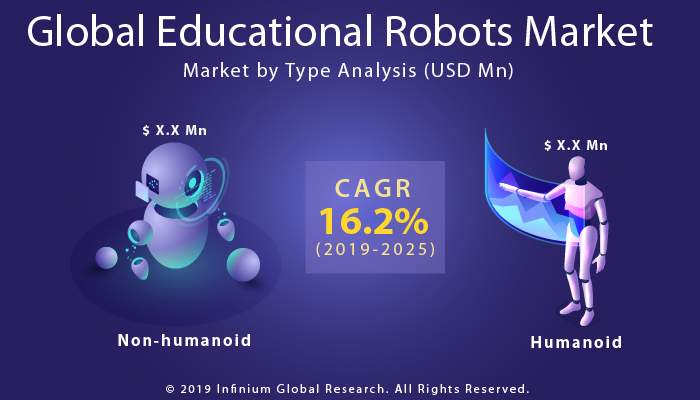Educational Robots Market (Component - Hardware, and Software; Type - Non-humanoid, and Humanoid; Education Level - Elementary and High School Education, Special Education, and Higher Education): Global Industry Analysis, Trends, Size, Share and Forecasts to 2025
A recent report published by Infinium Global Research on
educational robots market provides an in-depth analysis of segments and
sub-segments in the global as well as regional educational robots market. The
study also highlights the impact of drivers, restraints, and macro indicators
on the global and regional educational robots market over the short term as
well as long term. The report is a comprehensive presentation of trends,
forecast and dollar values of global educational robots market. According to
the report, the global educational robots market is projected to grow at a CAGR
of 16.2% over the forecast period of 2019-2025.
Market Insight
Educational robotics is a transformational tool for learning,
coding, computational thinking, and engineering. It is included within the
science, technology, engineering, and mathematics education. Educational
robotics helps students to develop teamwork and co-operative skills,
communicate and learn different advanced technological platforms. Additionally,
it helps the students to know their strengths, weaknesses, and passion and will
create knowledgeable leaders for tomorrow. Moreover, it is helpful solutions
for those students who cannot attend school.
An educational robot is a special tool for early and special
education. Nowadays, there are many education robots are available for children
and young people. Furthermore, the major factor such as advancements in
technology in robotics and the use of robots for educational purposes drives the
growth of the global educational robots’ market. Additionally, growing expenditure
in the field of research and development coupled with growing popularity about
educational robots as a learning tool is likely to have a positive impact on
market growth. However, the high cost of education robots is expected to hamper
the growth of the educational robot’s market. Furthermore, the growing demand
for humanoid robots is expected to provide growth opportunities for the global
educational robots market.
Among the region, the global educational robots market is
segmented into North America, Europe, Asia Pacific, and RoW. North America and Europe are dominating the
global educational robots market. This
is due to the growing adoption rate of education robots in numerous educational
institution. Technological advancement and science-related intellectuality in
children are helping to the market growth.
The emergence of affordable educational robots along with increasing
adoption of classroom automation equipment in the regions are some factors responsible
for the growth of the market in the Asia Pacific region. The Middle East and
Africa region is projected to witness modest growth over the forecast period.
Segment Covered
The report on global educational robots market covers segments
such as component, type, and education level. On the basis of component, the
sub-markets include hardware, and software. On the basis of type, the
sub-markets include non-humanoid, and humanoid. On the basis of education
level, the sub-markets include elementary and high school education, special
education, and higher education.

Companies Profiled:
The report provides profiles of the companies in the market
such as Blue Frog Robotics, Aisoy Robotics, Wonder Workshop, Probotics America,
Qihan Technology Co., Hanson Robotics Limited, PAL Robotics, Robotis, SoftBank
Group, and Other Companies.
Report Highlights:
The report provides deep insights into the demand forecasts,
market trends, and micro and macro indicators. In addition, this report
provides insights into the factors that are driving and restraining the growth
in this market. Moreover, The IGR-Growth Matrix analysis given in the report
brings an insight into the investment areas that existing or new market players
can consider. The report provides insights into the market using analytical
tools such as Porter's five forces analysis and DRO analysis of educational
robots market. Moreover, the study highlights current market trends and
provides forecast from 2019-2025. We also have highlighted future trends in the
market that will affect the demand during the forecast period. Moreover, the
competitive analysis given in each regional market brings an insight into the
market share of the leading players.
